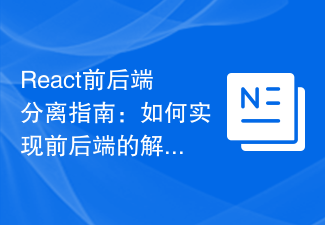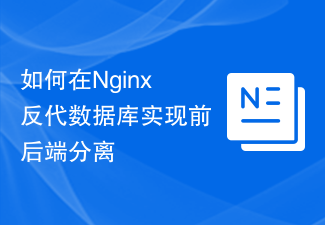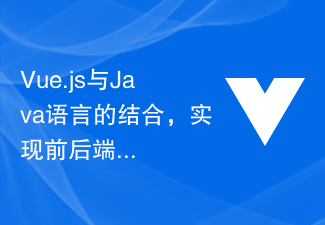 Web Front-end
Web Front-end Front-end Q&A
Front-end Q&A What is the difference between front-end and back-end separation and non-separation?
What is the difference between front-end and back-end separation and non-separation?Difference: When the front-end and back-end are not separated, the effects seen on the front-end page are controlled by the back-end, and the back-end renders the page or redirects, that is, the back-end needs to control the display of the front-end and the coupling between the front-end and the back-end. The degree is very high. In the separation of front-end and back-end, the back-end only returns the data required by the front-end, no longer renders HTML pages, and no longer controls the effects of the front-end. The coupling between the front-end and the back-end is relatively low.

#The operating environment of this article: windows10 system, thinkpad t480 computer.
Related recommendations: "Programming Video"
1. The concept of front-end and back-end separation
1. Front-end and back-end separation
- Front-end and front-end separation is an architectural pattern. To put it simply, the page cannot be seen in the back-end project
(JSP | HTML), the back-end provides an interface to the front-end, the front-end just calls theRESTstyle interface provided by the back-end, and the front-end focuses on writing the page(html|jsp)and rendering(JS|CSS|Various front-end frameworks); Just focus on writing code on the backend. - The core of front-end and back-end separation:The background provides data, and the front-end is responsible for display
1. Software architecture model
Most familiar with the MVC design pattern, Model—View-Controller Model-View-Controller
- How it works ? In layman's terms: you enter a URL
(Request)on the page, where does this URL go? Just call the interface(REST style). This interface is actually a piece of code (method) that accesses the backend. There are many methods in the backend. - How to determine which method is accessed? The interface is defined, for example:
177.25.26.7/idp/user/login, whereidprepresents a
service (a project),userrepresents a class,loginrepresents the specific method to be called. Once you press Enter, the backend method is directly called, and the backend method goes to the database(MySQL| Oracle|Others)Get data. Each row of data in the database table represents an object, that is, aJavaBean, which is finally saved to the collection frameworkusingpojomethod ( List|Map|Set|etc.), the method returns this set, then the result of calling this interface is(Response)gives you a result set, and the front end gets the data. Then it is displayed through the page(html|Jsp). What the user sees is what theViewlayer does.
2. Reasons for separation of front-end and back-end
In the past, I heard that TDD (Test-driven development, test Driven development) can improve the quality of the code, so we implemented TDD; then, we heard that BDD (Behavior-driven development, behavior-driven development) can deliver products that meet business needs For software, we implemented BDD; later, we heard that DDD (Domain-driven design, domain-driven design) can separate business code and basic code, so we implemented DDD. Today, I heard that front-end and back-end separation is very popular, so we implemented front-end and back-end separation - this is the legendary HDD (Hype-driven Development).
Process: TDD -》 BDD -》 DDD =》 HDD
3. Advantages of front-end and back-end separation
The separation of front-end and back-end can well solve the problem of uneven division of labor between the front-end and front-end. More interactive logic is assigned to the front-end for processing, while the back-end can focus on its own work. For example, it provides API interface for permission control and calculation work. Front-end developers can use nodejs to build their own local server, develop directly locally, and then forward api requests to the background through some plug-ins, so that they can completely simulate the line. scene and decoupled from the background. The front-end can independently complete the entire process of interacting with users. Both can start working at the same time without relying on each other. The development efficiency is faster and the division of labor is relatively balanced.
The advantages are summarized as follows:
- Improve development efficiency
- Perfectly cope with complex and changing front-end requirements
- Enhance code maintainability
2. The difference between front-end and back-end separation and front-end and back-end non-separation
1. The front and back ends are not separated
- In the application mode where the front and back ends are not separated, the effects seen on the front-end page are controlled by the back-end, which renders the page or redirects, that is, the back-end needs to control the display of the front-end, and the front-end and The backend is highly coupled.
- This application mode is more suitable for pure web applications, but when the backend is connected to
App,Appmay not require the backend to return aHTMLWeb page, but just the data itself, so the original interface of the backend that returns the webpage is no longer applicable to the front-endAppapplication. In order to connect to theAppbackend, another set of interfaces needs to be developed. .
2. Separation of front-end and back-end
- #In the application mode of separation of front-end and front-end, the back-end only returns the data of the front-end. The required data is no longer rendered, the
HTMLpage is no longer rendered, and the front-end effect is no longer controlled. As for what effects front-end users see and how the data requested from the back-end is loaded into the front-end, it is up to the front-end itself. Web pages have their own processing methods, andApphas their own processing methods. method, but no matter which front-end is used, the required data is basically the same, and the back-end only needs to develop a set of logic to provide data to the outside world.In the application model where the front and back ends are separated, the coupling degree between the front end and the back end is relatively low. - In the application model where the front and back ends are separated, we usually call each view developed by the back end an interface, or API
- . The front end adds, deletes and changes data through the access interface. check.
The above is the detailed content of What is the difference between front-end and back-end separation and non-separation?. For more information, please follow other related articles on the PHP Chinese website!
 React前后端分离指南:如何实现前后端的解耦和独立部署Sep 28, 2023 am 10:48 AM
React前后端分离指南:如何实现前后端的解耦和独立部署Sep 28, 2023 am 10:48 AMReact前后端分离指南:如何实现前后端的解耦和独立部署,需要具体代码示例在当今的Web开发环境中,前后端分离已经成为一种趋势。通过将前端和后端代码分开,可以使得开发工作更加灵活、高效,并且方便进行团队协作。本文将介绍如何使用React实现前后端分离,从而实现解耦和独立部署的目标。首先,我们需要理解什么是前后端分离。传统的Web开发模式中,前端和后端是耦合在
 如何使用Java处理前后端分离的表单数据交互?Aug 10, 2023 pm 01:01 PM
如何使用Java处理前后端分离的表单数据交互?Aug 10, 2023 pm 01:01 PM如何使用Java处理前后端分离的表单数据交互?随着前后端分离架构的流行,前端通过AJAX请求向后端发送表单数据已经成为了一种常见的方式。在这篇文章中,我们将学习如何使用Java来处理前后端分离的表单数据交互。我们将使用SpringBoot作为后端框架,并通过一个简单的示例来演示整个过程。首先,我们需要创建一个SpringBoot项目并添加相关的依赖。在p
 快速理解前后端分离的本质(附架构图)Aug 05, 2022 pm 04:37 PM
快速理解前后端分离的本质(附架构图)Aug 05, 2022 pm 04:37 PM前后端分离是:软件技术和业务发展到一定程度,在项目管理工作上必须进行的一种升级,他是一个必然而不是一个偶然!说白了,就是公司部门架构的一种调整。
 如何使用Vue实现前后端分离和接口对接?Jun 27, 2023 am 10:09 AM
如何使用Vue实现前后端分离和接口对接?Jun 27, 2023 am 10:09 AM随着前端技术的不断发展,前后端分离的架构模式愈发流行。前后端分离的优点是显而易见的,前端和后端可以独立进行开发,各自有自己的技术选型和开发节奏,更能够提高系统的可维护性和可扩展性。而Vue作为当下流行的前端框架,更是能够带来更为优秀的用户体验。本文将详细介绍如何使用Vue实现前后端分离的架构模式,并演示接口对接的方法。一、后端实现对于后端的实现,我们可以选择
 如何在Nginx反代数据库实现前后端分离Jun 10, 2023 pm 12:01 PM
如何在Nginx反代数据库实现前后端分离Jun 10, 2023 pm 12:01 PM随着互联网技术的快速发展,前后端分离的思想也越来越被开发者广泛应用。前后端分离可以使得前端和后台的开发分离并行,提高开发效率,降低了开发的复杂性,提升了系统的性能和可扩展性。在前后端分离的架构中,前端通过接口向后端请求数据,后端将请求的数据进行处理,然后返回给前端。在这个过程中,Nginx可以发挥作用,通过反向代理技术来实现数据的传递和转发。本文将介绍如何在
 Vue.js与Java语言的结合,实现前后端分离开发Jul 29, 2023 pm 03:25 PM
Vue.js与Java语言的结合,实现前后端分离开发Jul 29, 2023 pm 03:25 PMVue.js与Java语言的结合:实现前后端分离开发前端框架Vue.js和后端语言Java都是目前非常流行和广泛使用的技术,它们各自在前端和后端开发方面都有很强大的能力。将Vue.js与Java语言结合起来,可以实现前后端分离开发,使项目的开发更加高效、可维护性更好。本文将介绍如何使用Vue.js与Java语言进行前后端分离开发,并给出相应的代码示例。创建V
 前后端分离开发中,Go语言和PHP、Java的选择之争Sep 08, 2023 pm 06:48 PM
前后端分离开发中,Go语言和PHP、Java的选择之争Sep 08, 2023 pm 06:48 PM前后端分离开发中,Go语言和PHP、Java的选择之争随着移动互联网的迅猛发展,前后端分离开发模式正变得越来越流行。在这种开发模式下,前端负责用户界面的展示与交互,而后端则负责处理数据的逻辑和持久化存储。对于后端语言的选择,目前市场上较为常见的有Go语言、PHP和Java。那么如何在Go语言、PHP和Java之间作出选择呢?本文将从性能、开发效率和生态环境三
 使用ThinkPHP6实现前后端分离Jun 20, 2023 pm 12:34 PM
使用ThinkPHP6实现前后端分离Jun 20, 2023 pm 12:34 PM随着互联网技术的不断发展,前后端分离成为越来越流行的一种开发模式。前后端分离将前端与后端进行物理上的分离,前端负责页面展示,后端负责数据处理和逻辑运算。这种模式可以有效地提高开发效率和应用性能,同时也能够降低开发成本。ThinkPHP是一款非常流行的PHP框架,它提供了丰富的开发工具和框架功能,可以帮助我们快速构建Web应用程序。在这篇文章中,我们将介绍如何


Hot AI Tools

Undresser.AI Undress
AI-powered app for creating realistic nude photos

AI Clothes Remover
Online AI tool for removing clothes from photos.

Undress AI Tool
Undress images for free

Clothoff.io
AI clothes remover

AI Hentai Generator
Generate AI Hentai for free.

Hot Article

Hot Tools

MinGW - Minimalist GNU for Windows
This project is in the process of being migrated to osdn.net/projects/mingw, you can continue to follow us there. MinGW: A native Windows port of the GNU Compiler Collection (GCC), freely distributable import libraries and header files for building native Windows applications; includes extensions to the MSVC runtime to support C99 functionality. All MinGW software can run on 64-bit Windows platforms.

mPDF
mPDF is a PHP library that can generate PDF files from UTF-8 encoded HTML. The original author, Ian Back, wrote mPDF to output PDF files "on the fly" from his website and handle different languages. It is slower than original scripts like HTML2FPDF and produces larger files when using Unicode fonts, but supports CSS styles etc. and has a lot of enhancements. Supports almost all languages, including RTL (Arabic and Hebrew) and CJK (Chinese, Japanese and Korean). Supports nested block-level elements (such as P, DIV),

WebStorm Mac version
Useful JavaScript development tools

Atom editor mac version download
The most popular open source editor

ZendStudio 13.5.1 Mac
Powerful PHP integrated development environment





